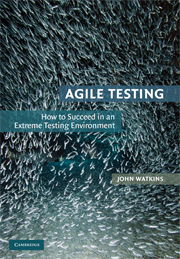Book contents
- Frontmatter
- Contents
- Foreword by Bob Bartlett
- Acknowledgments
- 1 Introduction
- PART 1 REVIEW OF OLD-SCHOOL AND AGILE APPROACHES
- PART 2 EVERYONE IS DIFFERENT: AGILE CASE STUDIES
- PART 3 AGILE MY WAY: A PROPOSAL FOR YOUR OWN AGILE TEST PROCESS
- APPENDIX A The Principles of Rapid Application Development
- APPENDIX B The Rules and Practices of Extreme Programming
- Appendix C The Principles of the Dynamic Systems Development Method
- Appendix D The Practices of Scrum
- APPENDIX E Agile Test Script Template
- Appendix F Agile Test Result Record Form Template
- Appendix G Agile Test Summary Report Template
- Appendix H My Agile Process Checklist
- References
- Index
Foreword by Bob Bartlett
Published online by Cambridge University Press: 26 October 2009
- Frontmatter
- Contents
- Foreword by Bob Bartlett
- Acknowledgments
- 1 Introduction
- PART 1 REVIEW OF OLD-SCHOOL AND AGILE APPROACHES
- PART 2 EVERYONE IS DIFFERENT: AGILE CASE STUDIES
- PART 3 AGILE MY WAY: A PROPOSAL FOR YOUR OWN AGILE TEST PROCESS
- APPENDIX A The Principles of Rapid Application Development
- APPENDIX B The Rules and Practices of Extreme Programming
- Appendix C The Principles of the Dynamic Systems Development Method
- Appendix D The Practices of Scrum
- APPENDIX E Agile Test Script Template
- Appendix F Agile Test Result Record Form Template
- Appendix G Agile Test Summary Report Template
- Appendix H My Agile Process Checklist
- References
- Index
Summary
It is fascinating to see that so many members of our global software development and implementation community are at last agreeing violently on the principles behind agile. It is gratifying to see developers and testers working side-by-side aiming for the same goals and supporting each other. If you didn't know what agile was but could see productive, disciplined, and self-organizing teams engaged in developing working software prioritized by business value, you would know that whatever they are doing must be right. Testers in particular have benefited from greater pride in their work as they are accepted as equal partners in the software development team.
Agile development and testing is a thirty-year-old overnight success; in fact, most of the younger developers and testers who so enthusiastically promote this new way of developing software had almost certainly not been born when the likes of Barry Boehm and James Martin first began to develop the Rapid Application Development (RAD) method!
Agile certainly seems to be being promoted as the latest silver bullet for all software development problems; the topic is included at pretty much any software event, user group, or standards group you attend, and much of the IT literature is full of agile references. For example, I recently hosted a conference on Software and Systems Quality and invited as a keynote speaker a senior development manager from IBM, who spoke of the corporate-wide initiative – spearheaded by the Chairman – to implement agile methods and processes groupwide.
- Type
- Chapter
- Information
- Agile TestingHow to Succeed in an Extreme Testing Environment, pp. xi - xiiPublisher: Cambridge University PressPrint publication year: 2009



